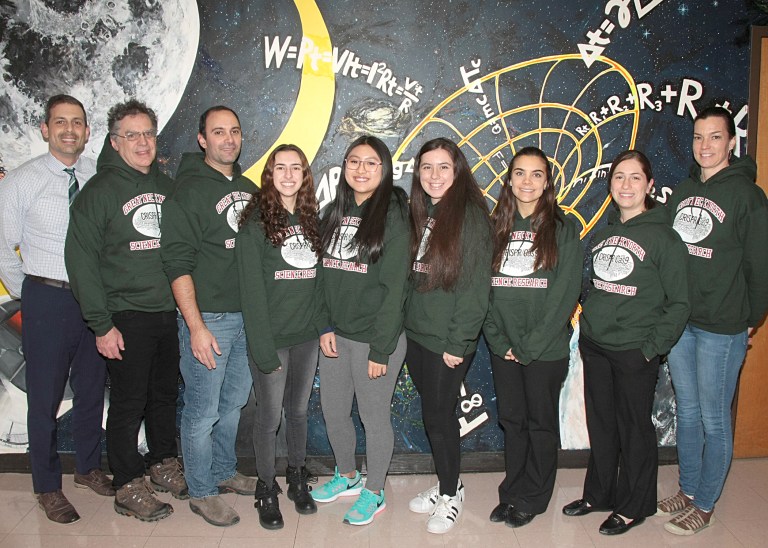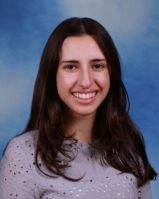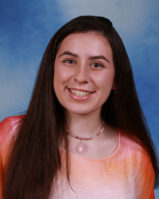
Three Great Neck North High School students are among nine high schoolers from Great Neck who have been recognized in the Regeneron Science Talent Search, one of the oldest and most prestigious science contests in the country.
Their research topics span engineering, earth science and neuroscience, their projects involving the creation of special gloves that could help the blind type on smart devices, understanding more about how microfossils are preserved and mapping the brain’s activity while someone is smiling.
They are Natasha Dilamani, 17, Amy Shteyman, 18, and Megan Xu, 17.
Natasha Dilamani

When Natasha Dilamani, 17, saw her sister, who is blind, have difficulty typing on a smartphone and iPad, it inspired a personal project that would ultimately get her recognized by the Regeneron Science Talent Search.
“Seeing her use iPads and iPhones, it made me realize she could use them well, but typing on them was difficult,” Dilamani, a senior at North High School, recalled in an interview.
Dilamani said this then prompted her to research into devices that could help her sister, but, “I noticed there weren’t many out there, and I wanted to create something new.”
The result was a pair of gloved with especially equipped braille sensors that bend in response to the phone sensors. This, in turn, makes it easier for someone who is visually impaired to type on their smart devices.
Dilamani said that she was honored – and a little surprised –to reach this point and be recognized. Then, When asked how she’d react if she was among the finalists, to be announced on Jan. 23, Dilamani said she’d likely be “speechless.”
“I’d probably be speechless, because this project I was working on, it was a homegrown project and I didn’t have this advanced input by a mentor,” Dilamani said.
Regardless of the end results of the science contest though, Dilamani, a member of the school’s neuroscience club, Key Club and two sports teams, said she intends to continue studying engineering in college.
Amy Shteyman

Amy Shteyman, a fellow semifinalist, said she had the chance to use new equipment built by the army and Israeli intelligence for a project expanding the science behind smiles.
More specifically, Shteyman said, she conducted a neuroimaging study to map brain activity that came from certain interactions that caused people to smile, whether it was with other people or inanimate objects.
“I found that there’s a difference in interactions when a person smiles at another person,” Shteyman said, noting that certain areas of the brain were much more strongly activated.
Shteyman said that neuroscience has always been a passion for her. It led her not only to found the school’s neuroscience club, she said, but also to pursue this project.
If she were to be a finalist in the Regeneron Science Talent Search, Shteyman said it would be “the biggest honor.”
“That would be the biggest honor,” Shteyman said. “Being able to present your work in Washington D.C. with Nobel Lauretes and all these very renowned people and accomplished people… I can’t even imagine.”
Regardless of the results, Shteyman said she intends to continue her neuroscience studies with Dr. Joy Hirsch, who mentored her through the project, at Yale University.
“For me, even getting into the lab and having the experience to work with such nice and exciting people in the lab, that’s what made me love research so much,” Shteyman said.
Megan Xu

Fellow scholar Megan Xu, 17, said she studied the preservation of microscopic lifeforms dating back 800 million years, and how organic carbon affects their ultimate transformation into fossils.
Xu said she found a negative impact, with carbon adversely affecting their quality. This discovery, she said, could help explain the differences between various microfossils from the era and why some species were preserved rather than not.
Her project idea originated from a program she attended from over the summer, as well as her mentor, Tina Woltz, a Ph.D student at the University of California Santa Barbara.
In addition to the research program, Xu has also been president of the Science Olympiad Club, where she said they get to “explore science topics that normally wouldn’t be taught in school,” and has been a member of the Nassau County Mathematics team.
“I didn’t get to take environmental science or in-depth earth science in high school,” Xu said.
Outside of school, Xu said she also has a love of music. She has learned at the “Manhattan School of Music” and has an upcoming honors orchestra event in March.
When asked what she would do if she advanced to the finals, Xu said she might be a little worried to miss the last day of the event, but that she would be very happy.
“I’d be super ecstatic that I’d get to go to Washington D.C.,” Xu said.
Xu, who recalled seeing scientific scholars on the school website when she was younger, also thanked the research program, the school and science research teacher Alan Schorn for being so supportive to the group.






